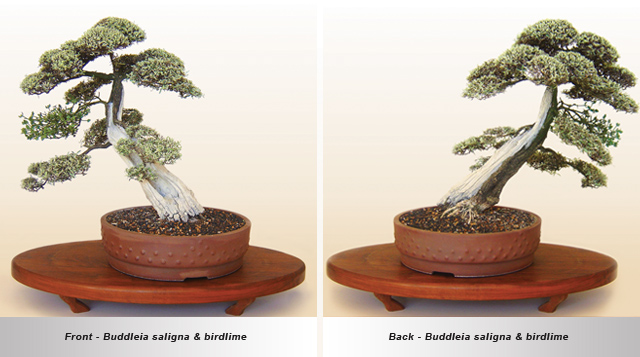Parasitic Plant – “birdlime”
In the spring of 1987 I collected a few ‘yamadori’ from the bush not far from my home. The plant specie would later become my favorite bonsai material namely the ‘buddleia saligna’. The stumps were planted in a coarse well-drained soil mixture and started growing quite well. One of the plants had a thick straight branch (12cm diameter), which I removed. This thick truncheon I stuck in the same soil mixture and to my surprise it made a few buds and started growing.
After a while I noticed some dark green leaves emerging from the stump, which were in sharp contrast with the pointed grey leaves of the rest of the tree. I realized this was not normal, but out of curiosity I allowed it to keep on growing. These green leaves were not buddleia leaves but the foreign leaves of a parasitic plant.
The parasitic plant is commonly known as “voëlent” which translates to “birdlime”. In late spring the parasitic plant produces small yellow flowers, which will develop into small bright red berries. The berries may be gathered and processed to become sticky glue, which is applied to branches often frequented by small birds. When the birds sit on the sticky branch, they can’t fly off and are caught by hand.
Birds eat the small red berries and the seeds are then deposited on trees. The fruity part of the seeds consists of very sticky substances, which make the seeds, stick to the bark of trees for a long time. The seeds germinate; form some type of root, which penetrate the bark and in some mysterious way make use of the host plant’s root system to survive and thrive.
The parasite is slower growing than its host plant. It has taken the parasite about twelve years to develop to its present state. I have used wire and the clip and grow method on the parasite during the development of the tree. I have noticed that the leaves of the host plant are quite a lot smaller than any of my other buddleia bonsai. Could it perhaps be because of the interference by the parasitic plant?
I think the root system of the parasite has interfered with the direction of the sap flow. The lowest branch on the right side of the tree is being nourished from above, in other words the sap flow has been reversed. It is one of the strongest characteristics of the buddleia to have specific roots feeding specific branches. In this case nothing makes sense.
The tree has been displayed twice at bonsai shows and it surely does make people stop, look twice, ignore my better trees and start asking questions which I can’t always answer!



